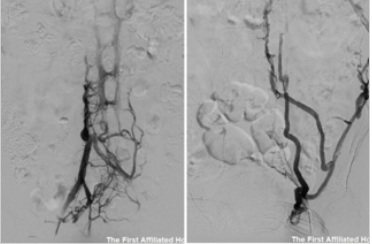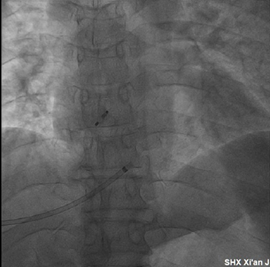On April 6, 2023, Department of Structural Heart Disease cooperated with Department of Gastroenterology, Department of Vascular Surgery and Department of Ultrasound Medicine to successfully perform "percutaneous transcatheter closure of patent foramen ovale (PFO) via hepatic vein puncture" for a patient with "Budd-Chiari syndrome complicated with inferior vena cava thrombosis occlusion, pulmonary embolism and extensive anterior myocardial infarction". According to literature review by authoritative organizations, it is the first case of this kind at home and abroad.
A male patient, 44 years old, surnamed Yang, was diagnosed with "acute ST-segment elevation myocardial infarction" complicated with Budd-Chiari syndrome, inferior vena cava thrombosis, left iliac vein thrombosis and pulmonary embolism. He was admitted to Department of Structural Heart Disease of the First Affiliated Hospital (FAH) of Xi 'an Jiaotong University (XJTU) for proper treatment. After inquiring regarding the disease condition, Deputy Chief Physician Wei Feng suspected the possibility of acute myocardial infarction caused by paradoxical embolism of venous thrombosis to the coronary artery rather than traditional myocardial infarction. The diagnosis ofparadoxical embolismwas made after comprehensive examinations. After clinical consultation, Associate Professor Hu Zhi suggested that this is a rare case in clinical practice and the possibility of myocardial infarction induced by venous thrombosis passing through the PFO into the coronary artery is extremely high. Closure of PFO can prevent the risk of fatal embolism of vital organs, such as heart and brain However, it was impossible to close the PFO via conventional femoral vein route due to inferior vena cava occlusioncomplicated with thrombosis (Figure 1).

Figure 1 Inferior vena cava occlusion
Professor Zhang Yushun stressed that closure of PFO will bring significant benefits to this patient in the long term, whereas it cannot be performed via conventional femoral vein route. In addition, reverse closure of PFO through jugular vein is extremely demanding and risky. He recommended use of forward closure of PFO via hepatic vein, which has a certain angle, but it can be performed in the forward direction. In theory, this technique can lowerinterventional operation difficulty and increase the success rate of PFO closure. After in-depth MDT discussion and consultation among Department of Gastroenterology, Department of Ultrasound Medicine, Department of Vascular Surgery and Department of Structural Heart Disease, it was agreed that percutaneous hepatic vein puncture was safe and feasible for PFO closure.
On the afternoon of April 6, Professor Wei Wei from Department of Ultrasound Medicine performed ultrasound-guided precision hepatic vein puncture for the patient (Figure 2). Subsequently, under the guidance of Director Wang Haiyan and Professor Zhang Yushun, Attending Physician He Lu cooperated with team members to complete PFO occlusion via hepatic vein (Figure 3). Under the cooperation from Department of Gastroenterology, the embolization and occlusion of percutaneous hepatic vein puncture wound were properly treated through jugular vein puncture. The operation time was two and a half hours.

Figure 2 Ultrasound-guided hepatic vein puncture

Figure 3 Successful closure of PFO through hepatic vein
Postoperatively, the patient was recovered well, the shape and position of occluder were normal, and no shunt was detected at the atrial level. Blood flow of hepatic vein was normal, liver puncture site was properly treated, and no bleeding was found. At postoperative 3 d, the patient did not feel any discomfort after off-bed activity.
The innovative procedures properly bypass the occlusion of the inferior vena cava route,which lower the difficulty, shorten the operation time and reduce the operation risk,compared with reverse operation via jugular vein.
This innovative surgery is another groundbreaking event after Department of Structural Heart Disease of the hospital completes the world's first case of "reverse transcatheter closure of PFO complicated atrial septal aneurysm by jugular vein puncture". Success of percutaneous transcatheter closure of PFO by hepatic vein puncture signifies that the hospital has mastered interventional closure techniques via "transcatheter femoral vein, jugular vein and hepatic vein routes" for patients with heart disease in the international community.